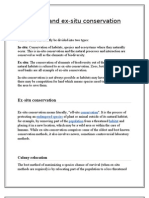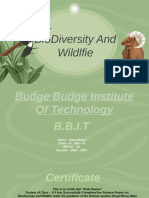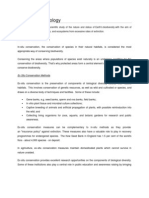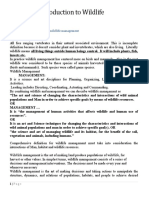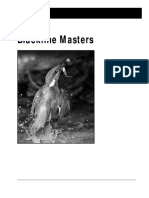Science Laboratory Practical 3: Ex-Situ Conservation
Science Laboratory Practical 3: Ex-Situ Conservation
Uploaded by
Kamariah EsaCopyright:
Available Formats
Science Laboratory Practical 3: Ex-Situ Conservation
Science Laboratory Practical 3: Ex-Situ Conservation
Uploaded by
Kamariah EsaOriginal Title
Copyright
Available Formats
Share this document
Did you find this document useful?
Is this content inappropriate?
Copyright:
Available Formats
Science Laboratory Practical 3: Ex-Situ Conservation
Science Laboratory Practical 3: Ex-Situ Conservation
Uploaded by
Kamariah EsaCopyright:
Available Formats
SCE 3107 Ecosystem & Biodiversity
Ex-situ Conservation
SCIENCE LABORATORY PRACTICAL 3 Ex-situ Conservation 1.0 2.0 Title : Ex-situ Conservation: Zoos & Botanical Garden
Introduction: There are two ways of biodiversity conservation which are in-situ conservation and ex situ conservation. In-situ conservation means "on-site conservation". It is the process of protecting an endangered plant or animal species in its natural habitat, either by protecting or cleaning up the habitat itself, or by defending the species from predators. The benefit to in-situ conservation is that it maintains recovering populations in the surrounding where they have developed their distinctive properties. As a last resort, ex-situ conservation may be used on some or all of the population, when in-situ conservation is too difficult, or impossible. Ex-situ conservation means literally, "off-site conservation". It is the process of protecting an endangered species of plant or animal by removing part of the population from a threatened habitat and placing it in a new location, which may be a wild area or within the care of humans. While ex-situ conservation comprises some of the oldest and best known conservation methods, it also involves newer, sometimes controversial laboratory methods. Zoos and botanical gardens are the most conventional methods of ex-situ conservation, all of which house whole, protected specimens for breeding and reintroduction into the wild when necessary and possible. These facilities provide not only housing and care for specimens of endangered species, but also have an educational value. They inform the public of the threatened status of endangered species and of those factors
Nur Suhaili Binti Saidin / PISMP Science January 2007 Intake
SCE 3107 Ecosystem & Biodiversity
Ex-situ Conservation
which cause the threat, with the hope of creating public interest in stopping and reversing those factors which jeopardize a species' survival in the first place. They are the most publicly visited ex-situ conservation sites, with the WZCS (World Zoo Conservation Strategy) estimating that the 1100 organized zoos in the world receive more than 600 million visitors annually--roughly ten percent of the world's population. 3.0 Questions and Answers: 1. What range of diversity is present ? How representative of total biodiversity at (a) a national and (b) a global level are these zoo and garden collections? Do they focus on particular groups and under represent others ? Explain. Ethnobotanical Garden is the one of the most largest species collectors for biodiversity conservation in Malaysia. In the global level of the range it is referred as a place where the scientist do their research to the certain species that are provided in the garden. Actually, the range cannot be determined as the life species in the garden that need different type of climate. The suitable plants for certain type of species is citronella oil (Cymbopogon Nardus), tongkat ali (IEurycomal longifilia) and so on. But, some species such as four season plants cannot be find here. The reason is by climate. The climate is not suitable for them. So the range of diversity is not representative as a global level garden collection. No, because the garden provides the different types of species and not focus on particular groups only. But this Ethnobotanical Garden conserve about 100 species herbal plants that collected from all Peninsular Malaysia, Sabah and Sarawak. Plant Discovery Garden is a place where it has some of the most interesting and unite plants in this garden. For example is native
Nur Suhaili Binti Saidin / PISMP Science January 2007 Intake
SCE 3107 Ecosystem & Biodiversity
Ex-situ Conservation
orchids, slipper orchids, pitcher-plants, aquatic plants, economic crops, bromeliads and the Venus Flytrap. In this garden, the range of diversity that present is representative of total biodiversity at a national and global level. The reason is the plants were collected from around the world. For example, the Venus Flytrap is the most spectacular tropical America plants. All plants here is divided in blocks according to their species, features and soil.
2.
What do in situ and ex situ mean? What are the merits and shortcomings of ex situ conservation? The term in situ conservation means taking care of biodiversity in its natural habitat. It also means protecting an important part of our natural ecosystems, the populations of natural wild species and, consequently, seeking to provide the minimal conditions required to maintain genetic variety in its natural state. The ex situ conservation of different species means taking care of them outside of their natural habitats. This method complements in situ conservation, especially when measures to recover and rehabilitate endangered species and reintroduce them to their natural habitats, are used. Facilities such as botanical gardens, zoos and aquariums are used to conserve plants and animals ex situ. The merits of ex situ conservation is makes it easier for scientist to study, research, distribute and use plant genetic resources. For example, the tigers. By conservation of ex situ, tiger is transferred to the new place or habitat. It is because of the natural habitat of the tiger s destroyed. The shortcoming of ex situ conservation is trying to breed the tiger in an environment or to create the new habitat like the natural habitat. But, ex situ conservation is more controlled than in situ conservation. So, we must understand clearly the needs of the animals
Nur Suhaili Binti Saidin / PISMP Science January 2007 Intake
SCE 3107 Ecosystem & Biodiversity
Ex-situ Conservation
and plants. If we want to conserve them, we must work fairly so that they will conserve well.
3.
Why do some ecologists believe that in situ conservation, by careful habitat management, is the only acceptable conservation strategy, and that it is unacceptable to maintain species which no longer have any natural habitat, or who are unable to breed in the wild, in zoos/gardens? Some ecologist believes that in-situ conservation, by careful habitat management, is the only acceptable conservation strategy because in situ conservation taking care of biodiversity in its natural habitat. This conservation does not need a high cost. Moreover, it is suitable for the animals or plants to live in their own habitat than the new habitat. By the way, it is unacceptable to maintain species which no longer have any natural habitat, or who are unable to breed in the wild, in zoos/gardens because of the new habitat is not same with the natural habitat. Furthermore, the new habitat is more costly. Sometimes some of the animals and plants cannot adapt well with their new habitat. So, they will not live longer at the place. Maybe they will die. It makes the population of the animals and plants become decrease.
4. Why do many people think it is not right to attempt to bring back extinct species such as the Tasmanian tiger? What are the conservation implications of these types of actions? Ex-situ conservation, while helpful in man's efforts to sustain and protect our environment, is rarely enough to save a species from extinction. It is to be used as a last resort, or as a supplement to in-situ conservation because it cannot recreate the habitat as a whole: the entire genetic variation of a species, its symbiotic counterparts, or those elements which, over time, might help a species adapt to its changing surroundings. Instead, ex-situ conservation removes the
Nur Suhaili Binti Saidin / PISMP Science January 2007 Intake
SCE 3107 Ecosystem & Biodiversity
Ex-situ Conservation
species from its natural ecological contexts, preserving it under semiisolated conditions whereby natural evolution and adaptation processes are either temporarily halted or altered by introducing the specimen to an unnatural habitat. In the case of cryogenic storage methods, the preserved specimen's adaptation processes are frozen altogether. The downside to this is that, when re-released, the species may lack the genetic adaptations and mutations which would allow it to thrive in its ever-changing natural habitat. Furthermore, ex-situ conservation techniques are often costly, with cryogenic storage being economically infeasible in most cases since species stored in this manner cannot provide a profit but instead slowly drain the financial resources of the government or organization determined to operate them. Seed banks are ineffective for certain plant genera with recalcitrant seeds that do not remain fertile for long periods of time. Diseases and pests foreign to the species, to which the species has no natural defense, may also cripple crops of protected plants in ex-situ plantations and in animals living in ex-situ breeding grounds. These factors, combined with the specific environmental needs of many species, some of which are nearly impossible to recreate by man, make ex-situ conservation impossible for a great number of the world's endangered flora and fauna. References:
1. Kooi F. Y & Ponnampalam J (2006), Excel in STPM Biology,
First Edition, Selangor Darul Ehsan: Penerbitan Pelangi Sdn. Bhd.
2. Wah M. C & Kim T. L. S (2007), Total Pro SPM Form 4 & 5
Biology, First Edition, Selangor Darul Ehsan: Sasbadi Sdn Bhd.
3. 4.
http://www.ipedia.net/information/in-situ+conservation http://www.ipedia.net/information/Ex-situ+conservation
Nur Suhaili Binti Saidin / PISMP Science January 2007 Intake
SCE 3107 Ecosystem & Biodiversity
5. 6. 7. 8.
Ex-situ Conservation
http://en.wikipedia.org/wiki/In-situ_conservation http://en.wikipedia.org/wiki/Ex-situ_conservation http://www.elbalero.gob.mx/kids/bio/html/conseva/exsitu.html http://www.elbalero.gob.mx/kids/bio/html/conseva/anp.html
Nur Suhaili Binti Saidin / PISMP Science January 2007 Intake
You might also like
- Australian Seeds: A Guide to Their Collection, Identification and BiologyFrom EverandAustralian Seeds: A Guide to Their Collection, Identification and BiologyNo ratings yet
- Institut Pendidikan Guru Kampus Dato' Razali Ismail: Ex-Situ Conservation: Zoos and Botanical GardensDocument7 pagesInstitut Pendidikan Guru Kampus Dato' Razali Ismail: Ex-Situ Conservation: Zoos and Botanical GardensMuhammad BaihaqiNo ratings yet
- Biodiversity and Conservation Strategies PDFDocument47 pagesBiodiversity and Conservation Strategies PDFPayal ShokeenNo ratings yet
- Bio DiversityDocument9 pagesBio DiversityAshwini Ashok KumarNo ratings yet
- 5) BIO 003 (Water Prof.)Document13 pages5) BIO 003 (Water Prof.)Isiogu PeculiarNo ratings yet
- Ex Situ Conservation: R.R.Bharathi 2 Yr BiochemistryDocument20 pagesEx Situ Conservation: R.R.Bharathi 2 Yr BiochemistryVishal TakerNo ratings yet
- Living World Exercise 11th BiologyDocument5 pagesLiving World Exercise 11th BiologyA-2188 Saurabh SinghNo ratings yet
- RationaleDocument3 pagesRationaleNelchie DalenNo ratings yet
- 3cWfE - Research - Biodiversity ConservationDocument5 pages3cWfE - Research - Biodiversity ConservationErmiyas YeshitlaNo ratings yet
- GeneticDocument4 pagesGeneticnabeel nadeemNo ratings yet
- ButterflyDocument15 pagesButterflyshanhariselvi82No ratings yet
- Rida Genetics ArticleDocument8 pagesRida Genetics Articlenabeel nadeemNo ratings yet
- Ecosystem 1Document18 pagesEcosystem 1areeba khanNo ratings yet
- Made by Ifsita NaskarDocument29 pagesMade by Ifsita Naskarsulatanaskar24No ratings yet
- Extra Notes Speciation and Bio DDocument7 pagesExtra Notes Speciation and Bio DtkomalshNo ratings yet
- Biodiversity and Genetics Resources PBG606Document18 pagesBiodiversity and Genetics Resources PBG606Naseer AhmedNo ratings yet
- Lecture V - Conservation BiologyDocument6 pagesLecture V - Conservation BiologyDaniel C. WalshNo ratings yet
- Biodiversity Conservation Ex Situ and in SituDocument9 pagesBiodiversity Conservation Ex Situ and in SituHarsh Vardhan SinghNo ratings yet
- Wildlife For ExitDocument58 pagesWildlife For Exitahfk191919No ratings yet
- Chapter I - Zoological and Botanical ThesisDocument6 pagesChapter I - Zoological and Botanical ThesisBruceler AdchakNo ratings yet
- Conservation Biology: in Situ Conservation MethodsDocument6 pagesConservation Biology: in Situ Conservation MethodsRenay KyokaNo ratings yet
- Biodiversity ConservationDocument25 pagesBiodiversity Conservationraosahab0140No ratings yet
- Zoo Biology, 16, 1-2.Document2 pagesZoo Biology, 16, 1-2.Sebas CirignoliNo ratings yet
- Chapter OneDocument12 pagesChapter OneErmiyas DebelaNo ratings yet
- ProDocument33 pagesProntrithvikreddyNo ratings yet
- Biodiversity and conservation (1)Document6 pagesBiodiversity and conservation (1)4L Anisha SieudassNo ratings yet
- Wild Endangered Animals Are Better Off in ZoosDocument2 pagesWild Endangered Animals Are Better Off in ZoosSantha SanthaNo ratings yet
- STS Activity 14 - DileDocument2 pagesSTS Activity 14 - DileChorizzo ElidNo ratings yet
- Life of Animals in Zoo - 2020 - 91064Document11 pagesLife of Animals in Zoo - 2020 - 91064OmkarNo ratings yet
- Animal Protection 2.0Document4 pagesAnimal Protection 2.0yoy fNo ratings yet
- Unit 6 Biodiversity and Conservation Semester 3Document5 pagesUnit 6 Biodiversity and Conservation Semester 3Kannu PriyaNo ratings yet
- Benefits of ZoosDocument4 pagesBenefits of ZoosQuoc Thai NguyenNo ratings yet
- Strategies For Conserving The Biodiversity and Genetic Resources of Natural EcosystemDocument15 pagesStrategies For Conserving The Biodiversity and Genetic Resources of Natural Ecosystemgeorgejain63No ratings yet
- Strategies For Conserving The Biodiversity and Genetic Resources of Natural Ecosystem PDFDocument15 pagesStrategies For Conserving The Biodiversity and Genetic Resources of Natural Ecosystem PDFgeorgejain63No ratings yet
- Dailo - BSTRM1-1D (#14)Document2 pagesDailo - BSTRM1-1D (#14)Laica Mae R DailoNo ratings yet
- KavinDocument12 pagesKavinsharveshsampathNo ratings yet
- Kavin PDFDocument11 pagesKavin PDFsharveshsampathNo ratings yet
- Conservation EssayDocument2 pagesConservation EssayBhavya AhujaNo ratings yet
- Assignment No 3Document4 pagesAssignment No 3nabeel nadeemNo ratings yet
- The Creation of New Protected AreasDocument3 pagesThe Creation of New Protected Areasemmanueldaniels999No ratings yet
- Biodiversity 2.1Document21 pagesBiodiversity 2.1abhijeetmehetre69No ratings yet
- Geography Project APSDocument13 pagesGeography Project APSMohan GanagallaNo ratings yet
- Insitu and Ex Situ ConservationDocument6 pagesInsitu and Ex Situ ConservationkayannaNo ratings yet
- Sea Turtle Food Selection PaperDocument13 pagesSea Turtle Food Selection Paperkelcie.chiquilloNo ratings yet
- NINA 1Document1 pageNINA 1RICHARD SIMMONSNo ratings yet
- Trabajo de Ingles N1Document4 pagesTrabajo de Ingles N1alexsmaicollsaguilarNo ratings yet
- TCF Action PlanDocument34 pagesTCF Action PlanIsar DignadiceNo ratings yet
- Prac 3 Ex Situ ConservationDocument2 pagesPrac 3 Ex Situ Conservationytengku100% (1)
- Keshara Jayaweera ADPHY16008 Professional English and Personality DevelopmentDocument10 pagesKeshara Jayaweera ADPHY16008 Professional English and Personality Developmentkesharajayaweera45No ratings yet
- Ex Situ ConservationDocument29 pagesEx Situ ConservationmatrixpushkarajNo ratings yet
- Conservation of BiodiversityDocument19 pagesConservation of BiodiversityAnkit AgarwalNo ratings yet
- In and Ex-Situ ConservationDocument4 pagesIn and Ex-Situ ConservationDeric JoseNo ratings yet
- Mind Faces - Bio Easy Notes Chapter 1 - Living WorldDocument6 pagesMind Faces - Bio Easy Notes Chapter 1 - Living Worldkhushi.kadam1208No ratings yet
- About OrangutansDocument8 pagesAbout OrangutanskaungthihaNo ratings yet
- Biodiversity: Threats and Conservation: StructureDocument21 pagesBiodiversity: Threats and Conservation: StructureramanNo ratings yet
- The Prepper's Ultimate Forager's Bible - Identify, Harvest, and Prepare Edible Wild Plants to Be Ready Even in the Most Critical SituationFrom EverandThe Prepper's Ultimate Forager's Bible - Identify, Harvest, and Prepare Edible Wild Plants to Be Ready Even in the Most Critical SituationRating: 5 out of 5 stars5/5 (1)
- Ex Situ Plant Conservation: Supporting Species Survival In The WildFrom EverandEx Situ Plant Conservation: Supporting Species Survival In The WildEdward O. GuerrantNo ratings yet
- How To Raise Quality Mealworms: A Comprehensive Guide For BeginnersFrom EverandHow To Raise Quality Mealworms: A Comprehensive Guide For BeginnersNo ratings yet
- Asia's Wildlife Safari: Encountering Exotic Animals and Nature's MarvelsFrom EverandAsia's Wildlife Safari: Encountering Exotic Animals and Nature's MarvelsNo ratings yet
- Revision Notes Class - 8 Science Chapter - 7 Conservation of Plants and AnimalsDocument3 pagesRevision Notes Class - 8 Science Chapter - 7 Conservation of Plants and AnimalsArpit SharmaNo ratings yet
- Current Status of Arabica Coffee (Coffea Arabica .L Genetic Resource: Conservations, Constraints and Mitigation Strategies in EthiopiaDocument11 pagesCurrent Status of Arabica Coffee (Coffea Arabica .L Genetic Resource: Conservations, Constraints and Mitigation Strategies in EthiopiaYared Mesfin FikaduNo ratings yet
- Fisheries, Ecology and Modelling An Historical PerspectiveDocument11 pagesFisheries, Ecology and Modelling An Historical Perspectiveguangyu LuNo ratings yet
- Annexure 7.8 Wildlife Conservation PlanDocument85 pagesAnnexure 7.8 Wildlife Conservation Plananand7602No ratings yet
- Introduction To Ecosystems (Teacher Example) Essential Questions NotesDocument9 pagesIntroduction To Ecosystems (Teacher Example) Essential Questions Notesapi-110789702No ratings yet
- Ocean Sunlight AssignmentDocument2 pagesOcean Sunlight Assignmentapi-286010542No ratings yet
- ObservationDocument34 pagesObservationAhmed El-AdawyNo ratings yet
- Mutualism in Architecture - An Architecture of The In-Between PDFDocument91 pagesMutualism in Architecture - An Architecture of The In-Between PDFKrisman Andika Yonas MarpaungNo ratings yet
- Assignment For Remedial StudentsDocument5 pagesAssignment For Remedial StudentsPoul GonaNo ratings yet
- Environmental Studies Syllabus - For All Faculties - 22.122020-1Document4 pagesEnvironmental Studies Syllabus - For All Faculties - 22.122020-1The GeniusNo ratings yet
- Insects and Their Chemical Weaponry New Potential For Drug DiscoveryDocument21 pagesInsects and Their Chemical Weaponry New Potential For Drug DiscoverygillNo ratings yet
- Abiotic and Biotic Elicitors-Role in Secondary Metabolites Production Through in Vitro Culture of Medicinal PlantsDocument32 pagesAbiotic and Biotic Elicitors-Role in Secondary Metabolites Production Through in Vitro Culture of Medicinal PlantsArya ChowdhuryNo ratings yet
- TSPSC Group 1 SyllabusDocument7 pagesTSPSC Group 1 Syllabuspannala.prashanthNo ratings yet
- Chapter 4 Section 1 OutlineDocument4 pagesChapter 4 Section 1 Outlineapi-263455059No ratings yet
- 12.1 Introduction To Bio-DiversityDocument23 pages12.1 Introduction To Bio-DiversitySamNo ratings yet
- Nutrition and EnvironmentDocument4 pagesNutrition and EnvironmentCelline PangestiNo ratings yet
- Tourism in Forest Areas of Western GhatsDocument51 pagesTourism in Forest Areas of Western GhatsEquitable Tourism Options (EQUATIONS)No ratings yet
- Deforestation and Forest DegradationDocument5 pagesDeforestation and Forest DegradationAniket MishraNo ratings yet
- IOI Agricultural Policy (Revised July05)Document197 pagesIOI Agricultural Policy (Revised July05)Hazwan Ab Halim100% (1)
- Science Power 10 Chapter Black Line Master PDFDocument39 pagesScience Power 10 Chapter Black Line Master PDFgiri_sundar5930No ratings yet
- Project On Waste ManagementDocument20 pagesProject On Waste ManagementRanjana chaudhary100% (1)
- Bureau of Land Management Vegetation Management HandbookDocument194 pagesBureau of Land Management Vegetation Management HandbookMark ReinhardtNo ratings yet
- Natural Vegetation LessonDocument30 pagesNatural Vegetation LessonAn SaNo ratings yet
- Summary of CredoDocument4 pagesSummary of CredoAmit MenonNo ratings yet
- Speech About BiodiversityDocument3 pagesSpeech About Biodiversity1l1l,No ratings yet
- Reforestation Challenges - ProceedingsDocument316 pagesReforestation Challenges - ProceedingsJumarie ypilNo ratings yet
- Popa Et All FinalDocument1 pagePopa Et All FinalPopa IonelNo ratings yet
- Developmental Research, Public Policy, and The Ecology of ChildhoodDocument5 pagesDevelopmental Research, Public Policy, and The Ecology of Childhoodcaka.productionhouseNo ratings yet
- Environmental Screening and Categorization: WB Safeguards Workshop April-May 2012 Agi KissDocument25 pagesEnvironmental Screening and Categorization: WB Safeguards Workshop April-May 2012 Agi KissAnurag KalvaNo ratings yet
- 5 - Randrianantoandro - Etal - 2010 - Population Assessments of Chameleons From Two MontaneDocument9 pages5 - Randrianantoandro - Etal - 2010 - Population Assessments of Chameleons From Two MontaneRaphaliNo ratings yet



